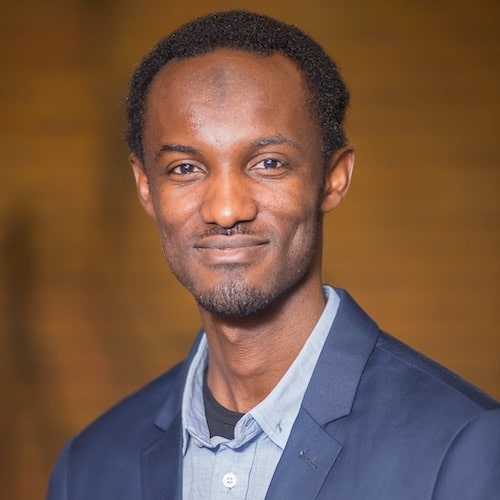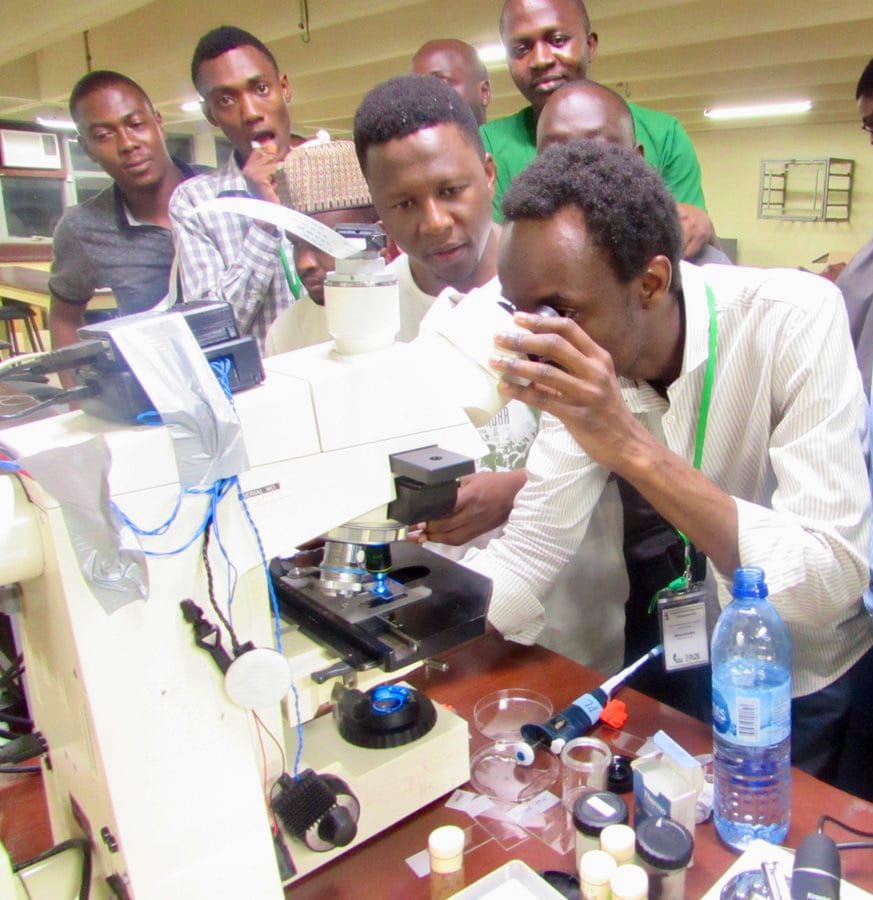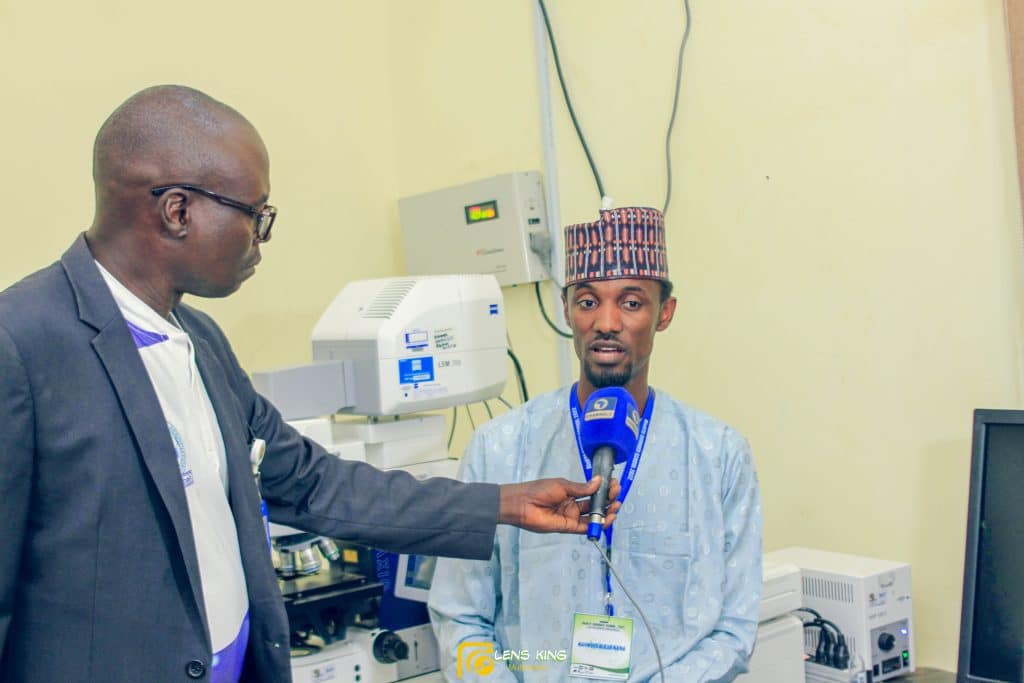Enhancing Global Access: interview with CZI grantee Mahmoud Maina
Posted by Mariana De Niz, on 24 January 2024

BIOIMAGING NETWORK IN WEST AFRICA
Mahmoud Maina is an Associate Professor at Yobe State University in Nigeria and Independent Research Fellow at the University of Sussex. He is the founder and Director of the biomedical Science Research and training Centre (BioRTC) at Yobe State University. His project aims to establish a West African Bioimaging Network to provide access and training to fluorescence imaging equipment. It will join 3 institutes: the Training Center in Yobe, Nigeria, the West African Center for Cell Biology of Infectious Pathogens in Ghana, and the MRC Unit in The Gambia. The network will integrate other institutes in West Africa, to provide access, from infrastructure and state-of-the-art equipment, to capacity building, and outreach to the young. Their long-term goal is to strengthen science capacity in Africa, contributing to change the narrative of science and research in the African continent.
What was the inspiration for your project? How did your idea for the CZI project arise?
Seventeen years ago, when I completed my BSc degree at the University of Maiduguri, Nigeria, I wanted to pursue a career in neuroscience, but then I realized the infrastructure as well as funding for neuroscience research is lacking in Nigeria, and this is the case in most African countries. For example, during my degree, were given a practical tour for an Electron microscope facility in our institution, only that, the microscope has been inactive 2 or 3 decades before I even joined the university. So I realized the only way for me to become a well-trained neuroscientist was to leave my country to a place where the discipline is well developed. I left Nigeria to the UK in 2011 for my MSc. I realized that the situation there was entirely different. The research environment was different: you could see that they had the right equipment, there were scientists doing science who were really excited to find the next discovery, so the atmosphere was completely exciting. And that’s what I wanted for my home. I wondered why we don’t have the same situation back at home. That’s when the idea to do something to change things arose in my mind. When I finished my MSc I returned back home. At the same time there was an NGO called TReND in Africa, founded by Dr Lucia Prieto and Prof. Tom Baden. I joined them because I had this idea of setting up a network of people from Nigeria with interest in neuroscience and their NGO had a similar but bigger ambition for neuroscience in Africa. In TReND, I founded the outreach program, bringing a team of scientists with interest in promoting science in Africa, to inspire change in science funding and awareness by organizing outreach activities to the public, policymakers, and students. Alongside doing that, I tried to set it up a neuroscience laboratory in 2 different universities in Nigeria, but it wasn’t successful because there was no sustainability afterwards. Actually, when you’re living in a resource limited setting, you have to think way ahead of your time. That’s how it started. By 2017 I realized that if I want to set up something that is going to be sustainable, I need a number of things to be there: local support, political support and external support and network. One also wants to ideally be from there, because the environment and the people and key stakeholders will see this as something being driven by someone from that location. This will increase the sense of acceptance in the community. So basically, that’s what happened. I approached Yobe State University in 2017 to start discussions about setting up a lab and they gave me a space and pledge their support. Due to this, I was able to launch the biomedical Science Research and Training Centre at the University in 2021. Quickly, we realized that for us to be able to succeed, we need to have a network. We need to learn from people who have succeeded but also where we can exchange information between one another and that’s exactly when CZI announced the call on global access to bioimaging. And so it was just a perfect opportunity for us to come together and develop a project like this.

Do you find that there are difficulties reaching out to everyone due to the language or aside of the resources – differences in establishments, visa issues, etc How easy is it to move around between your network?
It’s actually easy. In West Africa there is the ECOWAS (Economic Community of West African States) – a group of countries under one treaty which means your passport allows you to move around the countries that are part of the community without problems. In terms of the language, most of the countries speak English, although some, like Benin and Togo speak French. However, among the instructors for our courses, we have French speakers, which helps to overcome this language barrier .
I know that with CZI there was the creation of AMI and ABIC. Will you also join forces with them? How has this collaboration evolved?
We are working closely with the African Bioimaging Consortium (ABIC) and the African Microscopy Inititative (AMI). Mike Reiche and Caron Jacobs lead both ABIC and AMI. I am also one of the Executive Representatives at ABIC. The idea behind ABIC is that they want to integrate all the imaging communities within Africa. Because we are so few, we have to work together to ensure that happens. One important thing to mention is that we need more places across all of Africa with imaging technology to be able to come close to replicating some of the advancements in imaging achieved outside the continent. AMI is the only place in Africa with some of these high-end technologies, but it is located in South Africa. People from other parts of Africa have to go there to access these technologies. So one challenge with this approach is that no everyone can access it. For example, getting visa to South Africa is usually a problem for some nationalities. Moreover, for a continent as big as Africa, the resources in AMI are still not enough to meet the demands of the growing number of imaging scientists in Africa. This is why smaller hubs like BioRTC are very useful. Having such smaller open access hubs with some technologies in different places would greatly help in promoting access to imaging in the continent. We need a sort of triaged way – the smaller hubs to decently equipped to be the first point for researchers, and then for the more advanced imaging experiments, researchers can go to places like AMI. In terms of collaboration, we’ve actively engaged with ABIC by participating in conferences they’ve organized, which has been instrumental in learning and networking. Additionally, we have hosted members of ABIC in our webinars and have worked alongside them to foster global connections with other imaging communities. This synergy has been pivotal in securing another CZI grant through global collaborations that we joined aimed at enhancing the training of scientists, covering a spectrum from basic to clinical imaging, and ranging from molecular to human studies. These collaborative efforts are vital in strengthening our imaging science capabilities across Africa.

You were already doing a lot of the work before the CZI, you were establishing centers and networking. How instrumental was the CZI for you to reach your goals?
The CZI funding was what actually breathed life into us at BioRTC. We had lots of ideas, but we didn’t really have the financial backing to enable us to actually put our plans into action. This funding helped us do the following:
- Strengthen BioRTC in developing into an open-access hub, allowing people from different places to conduct their science within Africa without having to leave the continent. This is crucial as it helps to reduce brain drain and inspires the community and other scientists that they can establish similar hubs with the right motivation.
- Enable our host institution and local community in Nigeria to better appreciate the value of science. Through the CZI funding, we brought experts from within Africa, Europe, and America to our region to train local scientists and others, on the scientific processes that can help solve societal challenges through science and improve teaching methods. This effectively brought international training to the local community.
- Encourage further support from our government and policymakers. The funding demonstrated what we could achieve with the right support, showing that with their backing, our local scientists could gain exposure and skills to secure more funding for developing local solutions through innovation.
- Build further collaborations with local and international institutions. For example, we developed a collaboration with the Bioscience Technology Facility at the University of York, which led to three staff members from our center receiving imaging training at the University of York. This was followed by a generous donation of an LSM 780 Laser Scanning Confocal Microscope to our facility.
In a nutshell, it has given us visibility, local and international support, and collaboration, invigorating our center and inspiring the entire community.
One thing I want to mention about the CZI is their flexibility. They understand that each community has its own challenges and that a one-size-fits-all approach does not work globally. This flexibility is vital, and all funders should strive to emulate it.

How do you ensure for your training programs that the selection of participants is inclusive? Has that been an issue that you faced and how to you go about it?
This is precisely what we aim to address, especially given our region’s underrepresentation in educational access. From personal experience, I understand this challenge deeply. In our courses, experience with specific equipment like confocal microscopes is not a prerequisite. Our primary criterion is the applicant’s research potential and how our resources could contribute to their work. We prioritize applicants with research questions that our equipment can help address, enabling them to translate their ideas into action. Furthermore, we actively encourage participation from women, offering necessary support for those with childcare responsibilities during our courses. Our center operates as an open-access facility; anyone interested can apply by submitting a lab visit form, detailing their objectives and how our resources can facilitate their research. As of now, we are the only open-access facility in the region, to my knowledge, in Nigeria today.
How do you define democratizing microscopy and where do you see your project in the long term future?
We adopted an open science approach in our facility and in most things we do. When you are working in Africa, this is the way to go because paying for someone to install or fix an equipment, for example, is prohibitive. But if you can build your own stuff and fix your equipment, that saves you a lot of money. The CZI funds enabled us procure 3D printers and for our partners in Ghana and the Gambia and technicians trained in using them. We are encouraging the use of this approach for building parts for broken equipment, as well as equipment that we want to build – let’s say a smear-maker for malaria diagnosis. So we believe that by adopting this approach we will be able to build lots of microscopes at low cost, which we can now be able to either distribute or use in the center. That’s how you democratize access to microscopy, by also giving the skills, you are giving people the knowledge even if they are away from your center, they can also try to build it themselves and this is exactly also what attracted the attention of our government. They saw the microscopes that we started building, they saw that it’s low cost and they saw that it can be deployed into the local community to be used in healthcare delivery. I believe that the future lies in adopting open science approaches for everything that we do, as it will ensure sustainability too. In the long term, we envision expanding this open science model beyond our current regions, potentially creating a network of similar facilities across Africa. By doing so, we aim to establish a self-sustaining ecosystem that not only advances scientific inquiry but also directly contributes to improving healthcare outcomes through locally adapted technologies.
Going back to CZI, do they give you further support aside from the funding? Likewise, has being part of the grantee network been something positive for you, connecting with other grantees with similar views?
I’ve attended virtual events organized by CZI and this has helped me in many ways. For example, through this meeting I met Peter O’Toole, the Director of Imaging and Cytometry at University of York, which enabled us to build a collaboration that enabled two trainees from our centre to get trained in his facility. This visit led him to facilitate the donation of LSM780 microscope to our center. We are also discussing partnerships that will enable our trainees to visit his facility regularly for training. For this developing relationship, the executive governor of Yobe State visited Imaging and Cytometry to meet Peter and his colleagues and to strengthen the partnership we are building by expressing the governments support to our facility. Leonel from LABI has also reached out to me, saying they are happy to support us when needed. Leong the Director of the Advance Imaging Centre in Janelia, has also been extremely supportive. So actually, CZI activities has substantially helped us in building local capacity and international networks. One thing that I should add is that already within the 1st and 2nd year of our project we’ve trained over 140 people through the CZI funded project which is quite exciting. CZI bred life to our whole ambition, not just for us but also to the community. In Nigeria we’re the only open access community where people from all over are wanting to come for their research, so at the end of the day we have built something that is going to outlast these 3 years of funding of the project. It is giving inspiration to the next generation of scientists, because hopefully soon they won’t be forced to leave their country to do science elsewhere. Maybe this is something that CZI won’t understand, but actually this is something that has the potential to change the narrative of science in the region and it’s already doing so. Looking ahead, we aim to leverage these partnerships and continue the momentum generated by CZI’s support to further strengthen the regional science community and establish a lasting legacy of independent scientific excellence in Africa.
Check out our introductory post, with links to the other interviews here


 (1 votes, average: 1.00 out of 1)
(1 votes, average: 1.00 out of 1)